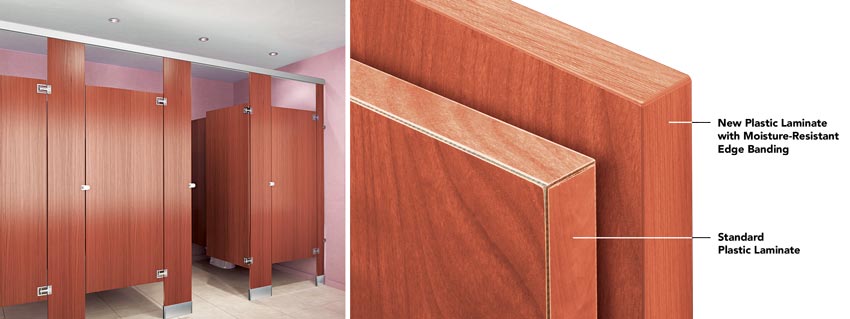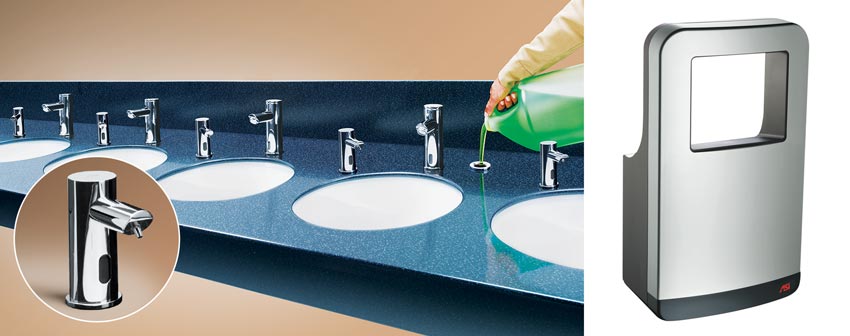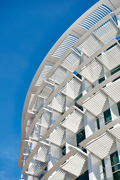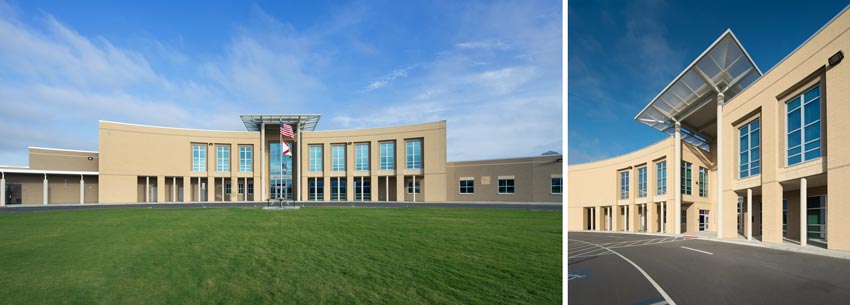Student Performance in 21st Century Schools
Individualization and Choice
The design parameter of having a choice in the way students interact with things in the building, like furniture, fixtures, and equipment (FF&E), was found by the Barret research team to help reinforce the notion of ownership and identification with the school in a positive way. High-quality and purposeful design in this area helped to reinforce outcomes in the classroom.
Architects and designers may or may not have much say in some of the FF&E choices in typical school building projects, depending on the client, the budgeting, and purchasing protocols. However, those things that are built in, such as lockers, bathroom fixtures, and accessories, are typically under the architect’s control and should be considered as fully as any other permanent part of the building. In fact, the proper design of bathrooms in a school can influence user experiences significantly more than the design of other parts of the facility. Since there are a wide variety of different products that meet different needs in bathroom and locker-room designs, product selection is instrumental in achieving not only a successful design but also in creating a long service life.
In developing specifications for these types of products, it is important to be aware of both the salient features and the material qualities of the different products being considered. Partitions in restrooms and locker rooms, for example, need to address appearance, functionality specific to the application, and durability. Given the presence of water and high humidity in some of these rooms, products that can stand up to those conditions, as well as the usual rigors of a school environment, are important. Of course, there is a desire to move away from cold, institutional appearances too, so such partitions need to provide an appropriate aesthetic. Plastic laminate partitions have been used as a cost-effective solution for this type of application, but they need to be properly selected and specified in order to avoid delamination or other problems. Toward that end, at least one manufacturer offers an edge-banding system (often the common weak point in the finish) that fuses with the substrate, creating a seamless beveled profile that eliminates any unsightly black lines that normally appear in standard plastic laminate. ASTM tests on this type of system confirm up to three times greater durability with increased resistance to moisture and humidity than standard plastic laminate. From a design standpoint, the edge banding is available in more than 40 different colors and patterns to match laminate on partition doors, panels, and pilasters.

Photos courtesy of ASI Group
The selection and specification of permanent furnishings and equipment in bathrooms and locker rooms in a school can directly influence the design appearance and functional performance of those rooms such as the toilet partitions shown here.
Looking at other aspects of a bathroom design in schools, attention to the permanent accessories can help with the smooth and long-term operation of restrooms, including the ability to easily maintain them. For example, soap dispensing systems often require a lot of time for maintenance staff to refill them on a regular, even daily basis. Products are now available in top-fill soap dispensing systems that can refill up to six soap dispensers with one pour. That saves time, but it can also mean that all dispensers are full and hands are actually washed at school, thus preventing the spread of germs and disease in school environments.
Hand drying is critical for good hygiene and hence an important detail in restroom design. The common options are paper towels and hand dryers, and while each have their pros and cons, there is room for both, even in the same washroom. One manufacturer even makes a three-in-one unit that has a paper towel dispenser, waste receptacle, and a built-in high-speed hand dryer.
While paper towels can generate waste and may be more expensive in the long run (since they are a consumable), there are instances where they are needed for uses besides hand drying, like cleaning up a mess in a washroom or even using them to avoid touching surfaces that people don’t want direct contact with.
As far as hand dryers go, high-speed hand dryers are more energy efficient and quicker (less than 12 seconds drying time). However, with high speed comes noise, which is not great for schools—consider hand dryers with lower decibel levels as well as ones that have the ability to adjust airflow and heat to meet specific needs. Hygiene is most critical in washrooms, and some hand dryers collect water in a trough—a breeding ground for bacteria—and often that water can overflow and spill onto the floor, creating a safety hazard. It is best to investigate hand dryers that have moisture management systems that in effect help eliminate bacteria and other hazards. Dryers that have triple filters (HEPA, odor-fighting, and anti-microbial layers) add a level of hygiene as well. In summary, the key in hand dryer selection is to find dryers that have high-performance parts so that they manage moisture, eliminate bacteria, keep decibel levels low, save energy, and also have the flexibility of adjusting air flow and heat to suit a school’s specific needs.
Cyrus Boatwalla, director of marketing, ASI Group, has a good bit of experience in this area, and architects he has spoken with agree with his observation that “a well-designed bathroom and locker room in an educational facility can be the deciding factor in elevating a building from ‘good to great’. Bathrooms and lockers rooms are more private and personal and are used much more frequently than entryways and building facades. If given the requisite attention to detail, a well thought out bathroom can make a much greater positive impact on the user experience of a building—thus influencing their opinion of the school, the town, and the architects who designed the building.”

Images courtesy of ASI Group
Permanent bathroom accessories, such as multi-fill soap dispensers and high-speed electric hand dryers, as shown here, can provide choices that make a positive impact on the perception of the people who use the school.
Conclusion
Architects, designers, education planners, and school administrators all need to make decisions about the design and construction of school buildings. Some of those decisions are appropriately based on individual experience and professional training. They can also benefit by being based on the work of researchers who seek to measure design variables in buildings and investigate the impact of those variables on students and other occupants, particularly in terms of how they influence learning. Basing designs on the findings and evidence found in such research (referred to as evidence-based design) allows everyone involved to make informed, up-to-date decisions. In that way, the design can truly make a more positive impact on the people who spend many hours each day inside schools and other buildings.
Notice

www.ambico.com

www.asi-accuratepartitions.com

www.c-sgroup.com/floormations-entrance-floors

www.c-sgroup.com/sun-controls

www.dormakaba.com

www.glengery.com

guardianglass.com

www.nanawall.com/applications/education

mitsubishipro.com/ready










